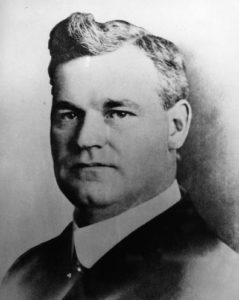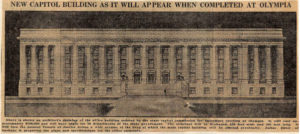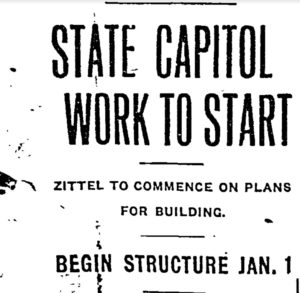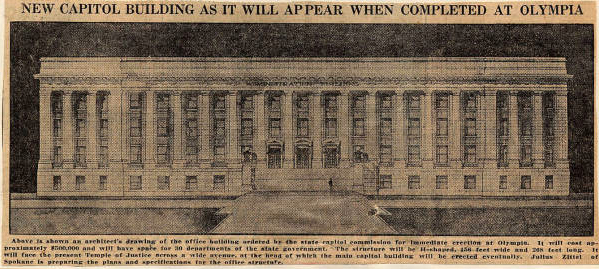The setting for Washington Governor Ernest Lister’s second inauguration in 1917 clearly illustrated his argument for building a new state capitol. At the time, Lister was only the second re-elected governor in state history and he aimed to use his political capital to take issue with the state of the state capitol, hoping to leave his mark as the architect of this new era of government.
 The inauguration was held in what was then the State House in Olympia, the former Thurston County courthouse which now houses the Office of the Superintendent of Public Instruction. The room was crowded with citizens and elected officials. There was a temporary wooden platform built in the crowded rotunda and other onlookers crowded the balconies.
The inauguration was held in what was then the State House in Olympia, the former Thurston County courthouse which now houses the Office of the Superintendent of Public Instruction. The room was crowded with citizens and elected officials. There was a temporary wooden platform built in the crowded rotunda and other onlookers crowded the balconies.
However, the building was not only packed beyond capacity at special events and ceremonies. When the legislature came to town, state agency staff would have to make way for legislative committees and other meetings, giving up their workspaces.

Lister was also a frugal politician, though, and his argument for a new state capitol building was bent towards getting it built on the cheap, fighting against plans already in motion for a grand and imposing capitol building design.
The most recent plans for a permanent legislative building in Olympia were just a few months older than Lister’s governorship, however he was was not sold on the grand vision.
Two New York architects, Harry Wilder and Walter White, had laid out plans for the state capitol in 1911 and 1912 and Lister came into office originally in 1913. As chair of the state capitol committee and as governor, Lister spent his first four years in office putting up funding and bureaucratic roadblocks to the development of the Wilder/White plan.
But by the start of his second term, Lister had waited long enough and wanted to move into temporary quarters across from the new Temple of Justice.
The Temple was the first installation of what would become today’s capitol campus as we know it. However, Lister mapped out a plan to put a halt to the grand domed legislative building that is the centerpiece of today’s campus and build a more sterile, temporary building in the same spot.
Almost immediately, the local chapter of the American Institute of Architects raised protest. But by the fall of 1917, developer Julius Zittel had settled in Olympia and was ready to lay into the 1911 work.

Wilder and White had won a design contest for the state capitol building plans in 1911 and spent the intervening years defending their plan and working on completing its first building, the Temple of Justice. Zittel was from Spokane and was (at least by implication as a fellow Democrat) politically connected to Lister. At the very least, Lister and Zittel shared the vision that the Washington state capitol should be much humbler that the Wilder and White plan.
And, by that November, another winner was announced in the contest to plan for the Washington State Capitol building.
From the Spokesman (Spokane) newspaper:
Wilder and White Group Idea Set Aside — Zittel Works on Details of Plans.
Governor Lister’s office building plan for the state capitol has won. Supporters of the $15,000,000 plans for the capitol group put out by Wilder and White have lost — temporarily, at least.
…
“The Wilder and White plan was never the most suitable, considering that it would involve expenditure of $15,000,000 while the state only has $5,000,000 in the capitol building grant to devote to the project,” Mr. Zittel declared.
The larger building would have served as a general state office building — housing up to 30 agencies that were then spread as far as Tacoma and Seattle — as well as a legislative building.
Eventually, in Lister’s and Zittel’s minds, what we consider the capitol would be centered on what is now the Winged Victory monument, and facing Capitol Way, not the current configuration.
It wasn’t better architecture and planning that eventually beat out Lister and Zittel, but rather bad health and war. The state capitol commission eventually let the plans for the new building go to bid in 1918, but the frugality argument began working against Lister and Zittel almost immediately. The United States had officially entered World War I before Zittel showed up in Olympia. By the time his plan was ready to go in 1918, American troops were on their way to Europe and the public will to spend on any new building waned.
Again, from the Spokesman:
When the legislative appropriation was made, the country was at peace. Now it is at war. Conditions have changed. The president and other high authorities at Washington are asking the people everywhere to forgo needless expenditure of public and private funds…
In April of 1918 the capitol commission put the Zittel capitol plan on ice, citing higher than expected costs.

The end of the Great War did not come soon enough for the Zittel building plan to become airborne again before the health of the architect’s benefactor, Lister, began to decline. Governor Lister had been suffering from heart and kidney disease since the summer of 1917, but finally gave over the reins of government to the Lieutenant Governor in early 1918. By June 1918, Lister had passed away.
After Lister’s death, the state capitol commission eventually found its way back to the Wilder and White group. Ground was finally broken in 1922, and the legislative building opened in 1928.
While this history of the state capitol building’s plans weaves its way through years of indecision, the eventual structure, what we see and visit today, is a solid symbol of the State of Washington and the seat of its government in Olympia.


















































